
Background information
A reflective nation: lessons in visibility from Finland
by Martin Jungfer

For many filmmakers, getting to work for the BBC, Netflix, National Geographic or Disney at least once in their lives is the ultimate dream. Underwater cameraman Nuno Sá, however, has managed to shoot footage for all these big names within a short space of time. In this interview, he reveals how his success came about and what fascinates him about his work.
If you’re fascinated by the underwater world, there’s a good chance you’re familiar with the work of Nuno Sá – even if the Portuguese cameraman’s name doesn’t ring a bell with you at first. Sá has worked on the iconic BBC series Blue Planet 2, Netflix’s Our Oceans (voiced by Barack Obama) and Disney’s OceanXplorers (produced by James Cameron).
He was also a finalist for a dive award at the international water sports trade fair Boot in Düsseldorf. In this interview, he reveals what drives him and gives aspiring underwater filmmakers some advice.
You have what many people would consider a dream job. How did it all start for you?
Nuno Sá: While I was in my second year of a law degree, I did a diving course in the Azores and absolutely loved it. Although I went on to finish my studies, I definitely wanted my life to be closely connected to the ocean.
How did you make that wish come true?
I started off by travelling to all the famous dive sites in the world, including Egypt and Australia. But my favourite was the place where it all began: the Azores. So I moved to the Azores island of São Miguel and was lucky enough to get jobs working in a diving store and on whale-watching tours right away. At the same time, I was studying marine biology.
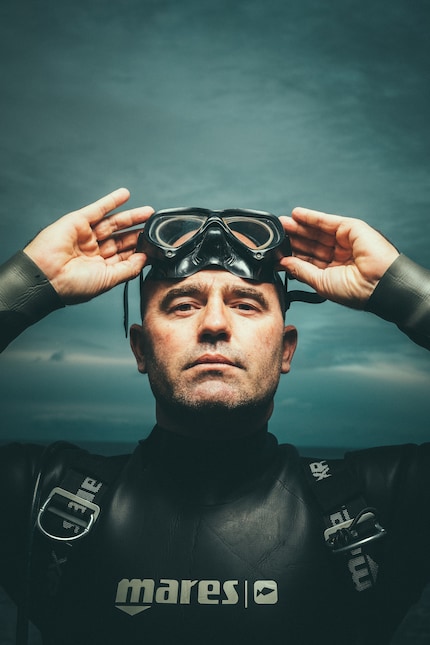
Then a camera came into the mix.
That’s right. I started off taking photos for my friends and family to show them how amazing the underwater world was. And I was always working on my photography skills. I had this incredible fascination for the ocean, and there was so much to see in the Atlantic around the Azores – whales, sharks, dolphins, octopuses. I was always discovering new things, including whale sharks, which weren’t previously known to live in that region. That’s also why I always talk to fishermen – they’re very knowledgeable.
You soon won a very sought-after prize. How did that come about?
In 2008, I got Highly Commended in the Mammals category of the Wildlife Photographer of the Year award. It was the first competition I’d ever entered.
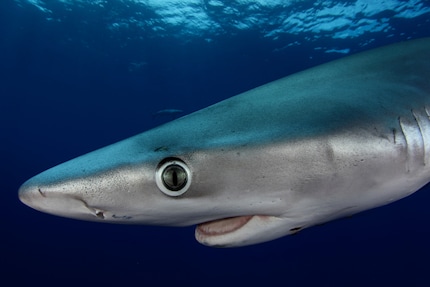
But not the last. In fact, you’ve won a whole host of awards. You were named Underwater Photographer of the Year in 2014 and bagged another important award in 2024.
That was the Save Our Seas Foundation’s Marine Conservation Photographer of the Year Award. I got it for an aerial photograph of a beached whale being pushed back out to sea by humans. It was a female sperm whale that had been hit by a ship. Every year, more than 20,000 whales die as a result of collisions with watercraft. As a professional underwater cameraman, the impact human beings have on the health of the oceans is becoming increasingly apparent to me. I’ve had the privilege of diving in every region spanning from the North to the South Pole, but I took this photo practically on my doorstep, on a beach near Lisbon. It stirs really mixed emotions in me. On the one hand, the injured sperm whale shows how much damage we’re doing to the oceans and their creatures as a result of shipping traffic, underwater noise, overfishing, plastic and chemical pollution. On the other hand, there’s a positive message: if we work together, we can change things for the better. Even though the whale didn’t survive, I believe everyone who tried to rescue it will end up contributing to the protection of marine mammals in some way.
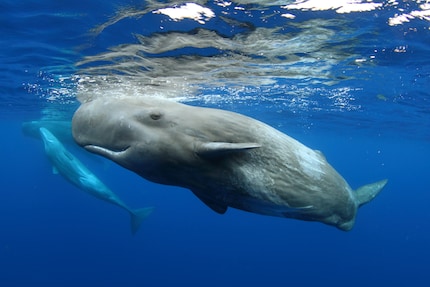
The main focus of your work is underwater films. How did you manage to get into that?
I started off taking photos of whale sharks in the Azores and wrote an article about them for National Geographic Portugal. That was my first paid photography gig. After that, I thought it might be possible to make a living from it. I tried my luck at asking a successful underwater cameraman from Canada for advice on what I could do to become a professional.
What advice did he give you?
He said to just keep doing what I was already doing. According to him, I didn’t have to travel the world. There were still so many untold stories in the Azores, and he advised me to stay there. That’s exactly what I did – and it worked.
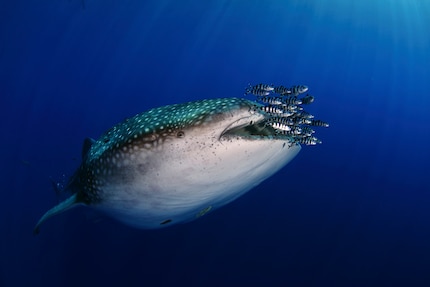
Very well, apparently.
Yeah, I was commissioned for BBC’s Blue Planet 2, my first ever film assignment. I then worked on the documentary Europe’s Wild Islands on National Geographic Wild. Other films such as the BBC’s Animals With Cameras or Islands of the Atlantic by the Japanese broadcaster NHK followed on from that. I’ve also worked for the broadcasters Arte, ORF and ZDF.
You’ve dived all over the world. What’s been your best experience so far?
That was when we were travelling for the Disney series Ocean Explorers. We – the cameramen and biologists – had a submarine so that we could go down really deep. Once we’d reached a depth of about 1,000 metres, the captain told us to switch off all our devices. Camera, monitors, the works. He then told us to close our eyes before flashing his headlights three times really brightly. Once we were in complete darkness again, we opened our eyes and saw that we were surrounded by millions of glowing, bioluminescent undersea creatures. Some of them looked like they were from another planet entirely. And behind them, there was just this endless expanse. It was such a unique and incredibly beautiful moment.
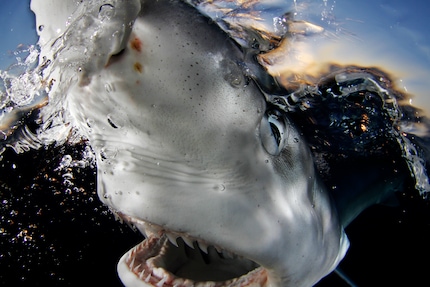
You come very close to sharks when you’re photographing them. Have you got into dangerous situations before?
Not with sharks. But one time, when I was working on the Netflix series Our Oceans, I was filming some giant bluefin tuna as they hunted. These fish grow up to four metres in size and weigh up to 700 kilos. Suddenly, I found myself caught in the middle of the hunting school and it went pitch black around me. They were swimming so close together that I was stuck inside the chaos for ages. Every gap that opened immediately closed again. Tuna can swim at speeds of up to 100 kilometres per hour and are really strong. If one of them had swum into me, there would’ve been serious consequences. Luckily, I managed to escape uninjured.
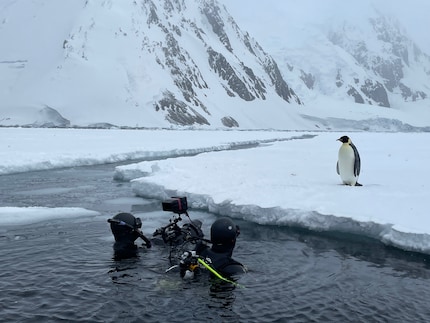
Your cinematic expeditions take you everywhere from icy bays to tropical waters. What equipment do you use?
I have 20–30 wetsuits so that I’m ready for any situation. I also have very specialised diving tools such as carbon freediving fins. Plus several rebreathers costing between 13,000 and 15,000 euros each. The one I go for depends on the requirements of the job.
And cameras?
My first camera, a Red, cost between 70,000 and 80,000 euros including professional underwater housing. These days, however, you can get pretty much the same thing for a tenth of the price or less. Cameras like the Sony Alpha 7s iii can now do what only much, much more expensive devices could do 15 years ago.
What advice would you give to someone who dreams of a successful underwater photography career?
Invest in a small system and capture footage somewhere you know better than anyone else does. It could be a lake near you or a piece of coastline. You don’t need to travel to the Maldives or the Galápagos Islands. Use your images to tell the stories you know really well. The key to success is showing what’s special about your area.
What are your next projects?
I’m working on an international IMAX production in the Azores this summer. Besides that, I’ll be producing a documentary for Portuguese TV about marine life in Portugal, spanning from the mainland coast to the Azores and Madeira. It’ll be like a Portuguese Blue Planet.
Nuno, thank you for the advice and insights into your life and work.
Research diver, outdoor guide and SUP instructor – I love being in, on and around water. Lakes, rivers and the ocean are my playgrounds. For a change of perspective, I look at the world from above while trail running or flying drones.
Interesting facts about products, behind-the-scenes looks at manufacturers and deep-dives on interesting people.
Show all